Ravellings on the knitted
sleeve -- Part I
To some knitters or would-be
designers, there is nothing so daunting as
designing a knitted sleeve that fits.
The problem with sleeves
-- whether the simple, boxy drop-shoulder
style, or those involving more intricate shaping
-- is that there always seems to be a whiff
of uncertainty about the finished product.
First, there's uncertainty
in length. A knit garment body that winds
up being an inch too long or short can be
camouflaged or forgiven, unless you're particularly
fastidious. But a long sleeve that misses
the wrist by an inch is an aggravation, especially
if it was knit from the wrist upwards. Knitting
the sleeve from the shoulder down to the wrist
makes lengthening or shortening easier, but
you may not get an accurate measurement of
the sleeve length until you have bound off
and blocked the sleeve.
And then there's the uncertainty
in determining a proper upper arm width. Both
a too-narrow and a too-wide sleeve can be
uncomfortable.
|
Armscye?
In
sewing, the opening in the garment body
through which the arm protrudes is called
the armscye (pronounced "arm's eye"),
which is a somewhat more graceful word
than the "armhole" used in knitting.
|
Finally, there's the uncertainty
of armscye depth. How much space do you need
to allow freedom of movement for the wearer's
arm? How shallow can you make an armhole without
uncomfortably binding the shoulder? Knitted
fabric, having some inherent stretch, can
accommodate a slightly snug fit, but hand
knitted fabric cannot compensate for gross
misjudgment.
So, if you're in the position
of having to add sleeves to an existing sleeveless
vest or top, or designing a garment from scratch,
how do you pick the right sleeve style, and
how do you crunch the numbers to make the
sleeves fit the body?
To answer these questions,
you'll need to be acquainted with the common
types of sleeves used for clothing, and what
measurements to take. In this issue, we'll
look at different types of sleeves and their
respective pros and cons, and then discuss
measuring and designing the simplest species
of sleeves: drop shoulder and modified drop
shoulder sleeves.

Drop
shoulder
What it looks like
The drop-shoulder style has the simplest
lines of any sleeve style. The body of the
garment is usually a simple rectangle, with
little, if any, shaping. The body width (the
rectangle width) extends past the actual shoulder
line of the wearer; in fact, if no sleeves
were added to the drop-shoulder body, the
shoulder portion of the garment would extend
into cap sleeves. The armscye is not shaped
at all.
The sleeve is also based
on a simple rectangle, usually with a taper
towards the wrist. The sleeve is shorter than
the wearer's actual arm; the upper edge of
the sleeve does not reach the shoulder. The
length of the upper edge of the sleeve equals
two times the depth of the armscye. Once assembled,
the sleeve extends from the garment body at
a right angle.
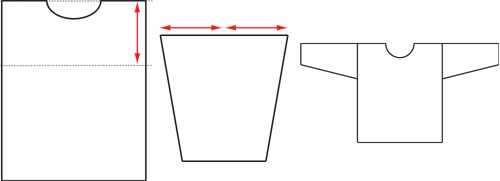 |
| A schematic
of a drop shoulder garment. When assembled,
the garment is distinctly "T" shaped,
and needs lots of wearing room [ease]
to fit properly. |
Assembly
If the garment is knit flat (i.e., with
the body in two pieces, a front and back),
a drop-sleeve pullover is assembled by first
seaming or joining the shoulders of the front
and back body, then centering the tops of
the sleeves with the shoulder seams, and sewing
or grafting the sleeves to the body. The whole
body is then folded in half at the shoulders,
and the side and sleeve seams sewn.
Alternatively, once the
shoulders are joined, the sleeves may be picked
up along the side edge, centered around the
shoulder seams, and knit down towards the
wrist. This eliminates some guesswork about
the length of the sleeves, since the garment
can be tried on before the cuffs are bound
off. (Of course, proper measuring and gauge
measurement techniques would eliminate this
guesswork as well, but picking up and knitting
downward also eliminates the armscye seam.)
The drop-sleeve garment
is also found in Norwegian-style sweaters,
typically worked in the round. If the entire
body is knit in the round, the armholes may
be cut and fixed afterwards using steeking
techniques. Otherwise, the upper body
may be split into two at the armholes, and
worked flat so that cutting is not necessary.
The shoulder seams are then joined, and the
sleeve is picked up all around the armhole
and knit in the round towards the wrist.
Pros
Because all seamlines are straight, this
style is easily adapted to be worked flat
or in the round.
The simple shape of each
piece makes for the easiest arithmetic
in calculating increases, decreases, and sleeve
length. The simple shapes also make it easy
to knit from the top down (shoulder to
wrist/hem) or bottom up (wrist/hem to shoulder).
The simple shapes also make
it easy to centre colour or texture patterns
without concern for interruptions. As
there is no armscye indentation, vertical
cable panels or colour designs can flow uninterrupted
along the edges of the front and back. That's
one reason you'll find many Aran-style sweaters
take advantage of the drop-shoulder style,
or its variant, the saddle shoulder. The only
concern you may have with a vertically repeating
pattern is ensuring that the repeats are not
cut off at an unattractive point.
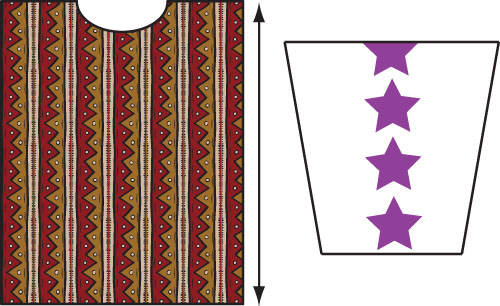 |
| Vertical
designs flow uninterrupted on a drop shoulder
garment; pay attention to where a pattern
repeat falls on the sleeve. |
Because the seam between
the sleeve and body is not intended or expected
to lie at the shoulder joint, the drop shoulder
style "forgives" an imprecise fit
at the upper body.
Cons
Some people feel the lower armhole seam looks
untidy. The drop shoulder can evoke visions
of oversized, sloppy sweatshirts, because
for the most part, drop-shoulder sweaters
are quite loose-fitting.
The drop-shoulder style
can also make the wearer appear broader
than he or she actually is. This is partially
due to the fact that the garment is likely
quite loose-fitting, but also because the
seam between the sleeve and garment body is
almost horizontal, drawing the eye across
the body. (If the sleeves are eliminated,
as in a cap-sleeve garment, the extended shoulder
of the cap sleeve will also draw the eye across
the body, again producing the illusion that
the wearer is wider than he or she really
is.)
Although the sleeve meets
the garment body at a right angle, the wearer
rarely maintains a scarecrow stance with arms
extended from the torso at ninety degrees.
When the wearer stands naturally, with arms
down at his or her sides, this means that
fabric may bunch up in the underarm area,
resulting in discomfort.
Drop shoulders are also
generally unsuitable for tight-fitting
or close-fitting pullovers. We'll explore
the reason why in more detail in next issue's
article on set-in sleeve shaping; but briefly,
when the wearer's arm is extended, the distance
required to travel from the neck, over the
shoulder, and down the arm is shorter than
when the arm is hanging straight down. When
the arm is lowered, there must be sufficient
ease in the garment upper body to cover that
extra length in the shoulder. In a drop-shoulder
style, that ease comes from a wider body.
Not only that, but a tight,
rectangular body just looks and feels uncomfortable.
Trust me.
Also, thanks to the generally
loose fit of drop-shoulder garments, a short
sleeve (or cap sleeve, if the sleeve part
of the garment is eliminated) is likely
to reveal foundation garments or less attractive
body parts when the arm is raised.
Variations
The disadvantage of an "untidy" appearance
or feel can be eliminated by substituting
a modified-drop-shoulder style, which
indents the upper part of the armhole seam
on the body to more closely resemble a shaped
armscye. The armscye seam may not rest exactly
at the shoulder line, but it is at least closer
to the shoulder.
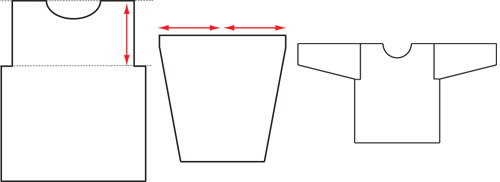 |
| A schematic
of a modified drop shoulder garment. When
assembled, the lines are similar to the
drop shoulder style. |
The disadvantages of a tighter-fitting
drop-shoulder garment can be alleviated by
imcorporating an underarm gusset,
which is used on traditional fishing ganseys.
The gusset is a diamond-shaped insert that
provides the extra ease necessary for natural
arm movement. Since it is usually formed by
adding extra increases to the body and sleeve
at the underarm, it doesn't have to look like
a diamond or an insert, but it can be
decorated to look like one if desired.
Another variant of the drop
shoulder, often used in combination with the
gusset on gansey-style sweaters, is the shoulder
strap. The strap is an extension of the
sleeve along the shoulder; the front and back
of the sweater are joined to this strap, rather
than to each other.
 |
| The schematic
for a gansey style. On the left side,
the shaping of an armhole gusset; on the
right, shoulder strap shaping. The neck
end of the strap may be widened to provide
a more accurate shoulder fit. |
If the sleeve extends from
the rectangular body at a right angle with
no seam, then the sleeve is a kimono sleeve.
When knitting a kimono sleeve, the assembly
method is similar to the dolman or batwing
sleeve, described below.

Set-in
What it looks like
The set-in sleeve style appears to
have simple lines when assembled, but the
shaping of the individual pieces is more complex
than the drop shoulder. The shoulder area
of the garment body is cut out so that the
whole arm is exposed. The armscye begins at
the side seam and curves towards the body
in a gradually increasing slope (in other
words, beginning with frequent decreases,
followed by less frequent decreases), until
the armscye line is more or less vertical.
The armscye edge does not extend past the
wearer's shoulder, unless the shoulder is
intended to be filled out with a shoulder
pad, or the garment is intended to be worn
over other layers, such as a coat or jacket.
The sleeve tapers from the
bicep line to the wrist. Above the bicep line,
the sleeve cap gently slopes to the shoulder
point. In knitting, the uppermost point is
actually a bound-off edge, between two and
four inches long.
The perimeter of the sleeve
cap is approximately equal to the total perimeter
of the armscye, which is greater than twice
the armscye depth (unlike the drop shoulder).
The height of the sleeve cap is less than
the depth of the armscye. Sometimes, the sleeve
cap perimeter is longer than the perimeter
of the armscye. In that case, excess fabric
can be gently eased in while sewing the armscye
seam.
When assembled, the sleeve
extends from the garment body at an angle
significantly less than ninety degrees, which
is closer to the usual position of the arm.
Often, knitted garments are designed so that
the sleeve cap and front and back armscye
are symmetric; in reality, our bodies aren't
that symmetric, but the stretch in knit fabric
allows for this tiny cheat.
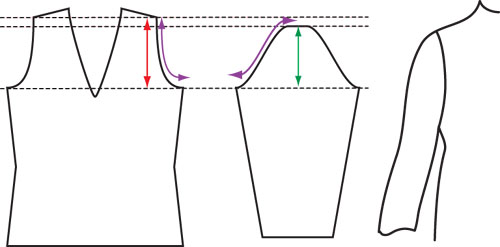 |
| The
schematic of a set-in sleeve garment.
When assembled, the angle between the
sleeve and body means less fabric bunches
under the arm, and a sleeker fit is possible. |
Assembly
Because of the shaping of the armscye and
sleeve cap, a set-in sleeve garment is usually
knit flat. The front and back body are joined
at the shoulders, and then the sleeve cap
is sewn into the armscye. Because a curved
edge is being matched to a (mostly) straight
edge, neat sewing is sometimes a challenge.
If necessary, any excess fabric along the
sleeve cap should be eased (slightly gathered)
to fit the armscye. Once the sleeve cap is
sewn in, the body side seams and the straight
sleeve seams are sewn.
Alternatively, the front
and back body first may be joined at the shoulder
and side seams, and the sleeve sewn into a
tube along its long seam. The sleeve is then
set into (hence the name, "set-in") the armscye,
matching the underarm seams together and the
centre of the sleeve cap with the shoulder
seam. This is usually the order of operations
used in sewing. In knitting, you'd use this
assembly method if the lower part of the body
was knit in the round, then divided for knitting
and shaping the upper body.
It is possible to pick up
and knit a set-in sleeve from the armscye
down to the wrist, but this technique will
require short rows to give the sleeve proper
shape.
Pros
Because it more closely mimics the wearer's
usual arm position, the set-in sleeve overcomes
the main disadvantages of the drop shoulder:
no fabric bunching in the underarm area, making
for a more comfortable fit, and vertical
armscye seams instead of horizontal seams,
which promotes a more slimming
look.
The shaping of the sleeve
cap provides the necessary "space" in the
garment's upper body required to allow for
freedom of arm movement, without having to
add extra room to the garment body in a manner
similar to the drop-shoulder style. This means
that the set-in sleeve style is suitable
for tight-fitting or close-fitting tops.
It's still good for looser clothing, as well.
If the sleeve is set into
a short-sleeved top, the closer fit around
the arm and shoulder means that raising one's
arm does not reveal any, ahem, unappealing
features.
Cons
The shape of the sleeve cap makes this sleeve
the most labour-intensive to calculate
and to sew to the garment body.
If the garment body is designed
around vertical panels, then vertical
designs will have to be interrupted or eliminated
in order to accommodate the indented armscye.
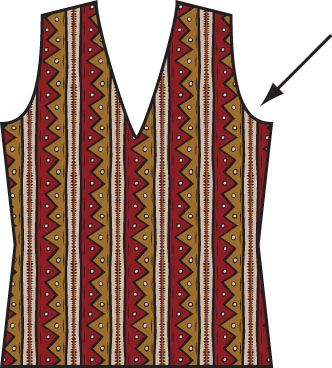 |
| Vertical
designs near the body edge will be interrupted
by the armscye shaping of a set-in sleeve
garment. |
Upper body fit is more important
with a set-in sleeve garment; when choosing
a size, care must be taken to ensure that
the finished shoulder width will fit the wearer.
If the garment's shoulders are too narrow,
the sleeve cap will have to stretch over the
wearer's shoulder; if the garment's shoulders
are too broad, they may result in an odd,
boxy profile.
Variations
Set-in sleeve garments may be combined with
gussets for a better fit, and shoulder straps
for a decorative look. The sleeve cap alone,
or the entire sleeve, may be enlarged to add
details such as a gathered cap or a shoulder
pleat.
Normally, the sleeve and
body are joined at a seam at or very near
the shoulder line; depending on current trends,
the seam may be extended beyond the natural
shoulder line (often requiring the use of
shoulder pads to fill out the shoulder area),
or cut slightly inwards (a "narrow shoulder"
look that was more popular in the late 1970s).
A summery variation of the
set-in sleeve is the use of a sleeve cap alone
to cover the shoulder, leaving most of the
upper arm bare.
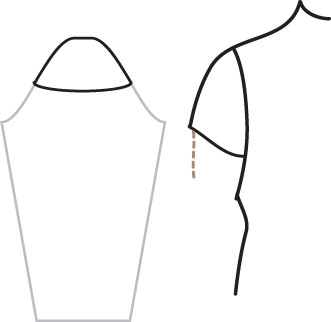 |
| The tiniest
of set-in sleeves. |

Raglan
What it looks like
The raglan style is often associated
with a casual or sporty look. Instead of positioning
an armscye seam over the shoulder, the raglan
sleeve seam slants from the underarm to the
neckline, with the result that the back, front,
and sleeve all taper towards the neck. Depending
on the garment design, the upper edge of the
raglan sleeve may form a substantial part
of the neckline, and may be shaped to blend
in with the curve of the front and back neckline.
Usually, the raglan seam
edges on the front, back, and sleeve are straight
lines, as they are formed by decreases (or
increases, if knit from the top down) at regular
intervals. Occasionally the seams may be curved
either as a design feature, or as a tweak
to fit in the correct number of decreases
before running out of upper body or sleeve
rows. The length of each raglan edge on the
sleeve is approximately equal to the length
of the corresponding raglan edges on the front
and back, although it is possible that the
sleeve edges may be a little longer, in which
case any excess fabric may be eased in gently.
When assembled, the sleeve
usually extends from the garment body at an
angle less than ninety degrees, but not as
small an angle as the set-in sleeve. The pitch
of the raglan seams determines the angle at
which sleeve and body meet. For example, it's
possible to have a raglan sleeve that extends
at a right angle from the garment body, if
the seams are angled at forty-five degrees
from the vertical.
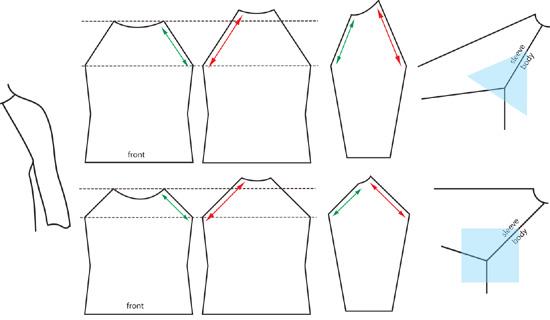 |
| Schematics
of a raglan sleeved garment. The angle
at which the sleeve meets the body depends
on the pitch of the raglan shaping on
both the sleeves and the body. |
Assembly
If the garment is knit in flat pieces, the
front, back, and sleeves are first knit. The
garment is assembled by sewing the front raglan
edges of the body to the front raglan edges
of the sleeves (if the sleeves are not symmetric,
the front raglan edges of the sleeves will
usually be shorter than the back edges), then
sewing the back raglan edges of the sleeves
to the raglan edges of the back body. The
underarm and side seams are sewn last.
If the garment is knit in
the round from the bottom up, usually the
body and sleeves are first worked separately
from hem (or cuff) to the underarm. The live
stitches of the body and sleeves are then
threaded onto a long circular needle, with
the live stitches of the upper sleeves lying
between the live stitches of the upper front
and back. Some underarm stitches on both the
body and sleeves are left on holders or waste
yarn. The upper body, with raglan decreases,
is then worked in the round up to the neck.
Because knitting in the round will yield a
front and back neck of the same depth, often
short rows may be added to the back to raise
the back neckline by about an inch or so.
The underarm stitches are then grafted or
bound off together.
If the garment is knit in
the round from the top down, the raglan lines
of the upper body are shaped using increases,
rather than decreases, to the bottom of the
armholes (as with knitting from the bottom,
short rows may be worked across the back to
raise the armhole). At that point, the sleeves,
front, and back must be divided out to separate
circular needles, double-pointed needles,
or holders; the front and back on one set,
and each sleeve on their own set. When the
body is worked using the front and back stitches,
additional stitches are cast on at the underarm
positions; similarly, underarm stitches are
added when the sleeves are worked downward
from the upper sleeve stitches. When the body
and sleeves are complete, the underarm stitches
are grafted or sewn together.
Pros
The lines of the raglan sleeve provide a more
sophisticated style than the drop shoulder,
while requiring only relatively simple
arithmetic. But like the drop shoulder,
the raglan style is also a forgiving shoulder
fit--there's no armscye seam to align
with the shoulder joint.
At the same time, the raglan
sleeve is easier to calculate and sew than
a set-in sleeve, while still providing some
of the same fitting benefits. Thanks to the
angled pitch of the arms, there's less
fabric bulk under the arms, and it's
not necessary to add as much extra ease
in order to fit the garment over the shoulder
area.
However, close and tight-fitting
raglans with shallow armholes may still be
uncomfortably tight, unless some other adjustments
are made to the shoulder area; for example,
by adding short row shaping at the shoulder
point to allow for movement. Alternatively,
the sleeve may be worked with extra wearing
ease up to the shoulder, with a sleeve dart
removing the extra ease once past the shoulder.
These alterations will provide a better fit,
but it does detract from the "forgiving shoulder
fit" advantage.
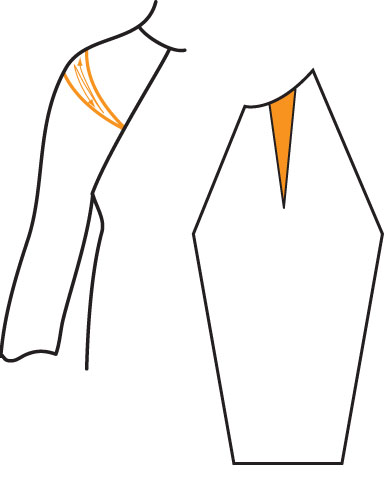 |
| Inserting
short rows at the shoulder point will
compensate for a tight fit under the arm;
additional decreases, creating a dart,
can also take up slack once the sleeve
meets the body |
The lines of the raglan make this style a
prime candidate for knitting from the
top down or knitting in the round, with
only underarm stitches to be grafted or sewn
together.
Also, either a pro or a
con depending on your point of view, the raglan
lines accentuate the shoulders, making
you look broader than you really are. This
aspect can be enhanced by working the sleeves
in a contrasting colour.
Cons
If the raglan sleeves extend from the garment
body at a ninety degree angle, or something
close to a right angle, then some of the same
fitting problems as for drop shoulder garments
will arise: excess fabric bunching under
the arms, and an unsuitability for
tight-fitting garments. That problem
can be alleviated by altering the pitch of
the raglan edges to something greater than
forty-five degrees.
Even non-right-angled raglan
sleeves may feel tight and binding in
a close-fitting garment, for similar
reasons as for the drop shoulder: there's
not enough room in the garment upper body
to allow for the curves of the shoulder.
Because of the sloped raglan
seams, vertical stitch or colour patterns
are interrupted. For example, the decreases
may interfere with an extra-wide central panel.
However, the decrease lines also provide an
opportunity for interesting design details.
If you're a busty body type,
there's a traditional caveat against the raglan
style. Whether you believe it (and whether
you think it's a pro or con) is up to you,
but some feel that the slanted lines of
the raglan sleeve call attention to the bust
area, highlighting an already ample figure.
Other people don't believe this, and argue
that it slightly diminishes the appearance
of the bust; both sides cite the slanted raglan
seams as the cause.
If you think it's a problem,
you can try working different decrease styles
to de-emphasize the seamlines, or use the
yoke sweater variation instead.
Variations
A construction method peculiar to knitting
is the yoked sweater, knit in the round. The
yoked sweater can be considered to be a graceful
adaptation of the raglan design, or vice versa.
In essence, the yoked sweater is raglan shaping,
distributed evenly around the shoulders and
chest, rather than concentrated at four seamlines.
Like the drop shoulder and
set-in sleeve, the raglan sleeve can be styled
with a shoulder strap. In that case, the "raglan"
portion of the sleeve ends sooner, and the
strap extends from the raglan portion to the
neck.

Dolman
What it looks like
The dolman style has a sleeve formed integrally
with the body, with only two substantial seams
at the underarms. A generous amount of space
is provided under the arms for movement, so
the garment is usually considered to be very
loose-fitting, even if the sleeve forearms
are tight.
Knitted dolman styles are
often designed as one-piece designs, to be
knit sideways (cuff-to-cuff) or continuously
from front to back. With this unitary construction,
the dolman sleeves almost invariably extend
from the body at a right angle. It is possible
to alter this shape to provide angled sleeves
with strategically placed increases and decreases
or short rows, or alternatively by working
the front and back separately.
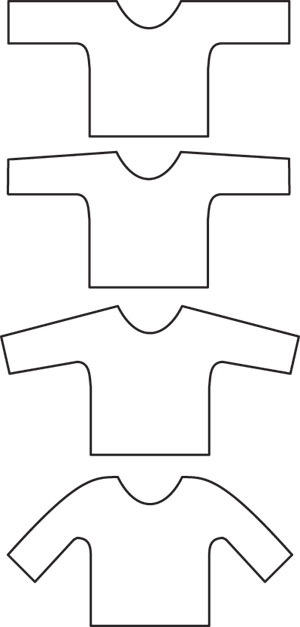 |
| A dolman
sleeved garment schematic. With clever
shaping or short rows, the sleeves can
be angled. |
Assembly
Because of the shape of the pieces, dolman-sleeved
garments usually knit flat. If a dolman-sleeved
garment is worked from bottom to top in two
pieces, for both front and back the body is
worked from the hem to the underarm, where
the sleeves begin; stitches are cast on at
the end of a number of consecutive rows until
the number of stitches added to each side
of the body is equal to the length of the
sleeve extension. Once half the circumference
of the cuff measurement has been worked, the
upper edge is gradually bound off over a number
of rows (with neck shaping as required). If
a less tapered sleeve is desired, the sleeve
extension cast-on or bind-off rows could be
worked over fewer rows. The front and back
are then seamed along the underarms and over
the tops of the sleeve and shoulder.
If the garment is knit in
one piece from front to back (or back to front),
the front (or back) is worked in a manner
similar to the front (or back) of a two-piece
dolman garment, but it is not bound off at
the upper edge. Instead, the body on either
side of the neck is worked, with neck shaping
(decreases and increases) until the neckline
on the back (or front) can be completed. Extra
stitches are cast on in the middle of the
next row to join the body back (or front)
together; bind-off rows shape the lower edge
of the sleeve, and then the body is knit to
the back (or front) hem. To assemble, the
garment is folded together at the shoulder,
and the underarm seams are sewn.
If the garment is knit in
one piece sideways (cuff-to-cuff), the first
cuff is cast on, and increases shape the sleeve
until the body begins; extra stitches are
cast on at the end of two consecutive rows
to equal the length of the body extension.
When the depth for the neckline is reached,
stitches are decreased or bound off to add
the shaping; increases or cast-on stitches
close the neckline on the other side. Two
more bind-off rows create the body sides,
then the sleeves are gradually decreased to
the second cuff. To assemble, the garment
is folded together at the shoulder, and the
underarm seams are sewn.
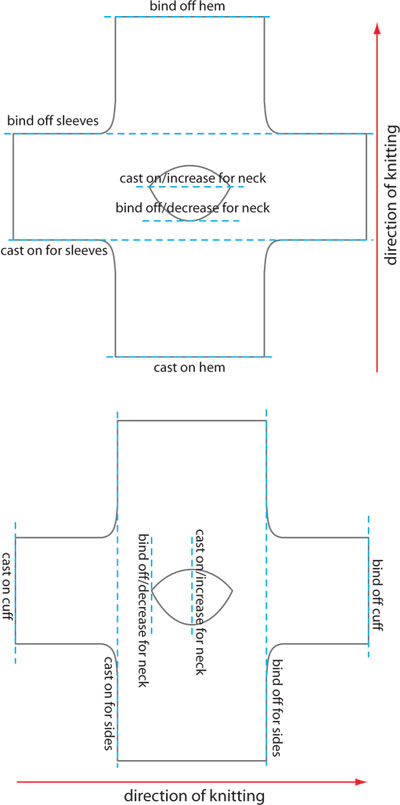 |
| The order
of construction for a one-piece dolman
sweater, from hem to hem or side to side. |
Pros
As noted above, if you're a fan of sideways
knitting, the dolman is perfect for a
cuff-to-cuff sweater.
If you choose to knit the
garment with the front, back, and sleeves
as a single piece, it's also the simplest
style to assemble, with only two underarm
seams to sew. This makes it an excellent choice
for lacy or holey fabrics (think novelty ladder
or confetti yarns) that just don't seem to
take seaming gracefully.
Dolmans also provide for
continuity of pattern from sleeve
to body, if the garment is knit sideways (there
will be an interruption at the neckline),
or over the shoulder, if the garment is knit
from front to back.
The dolman sweater is easy
to fit for similar reasons as the drop
shoulder, as there is no cross-shoulder seam.
Cons
If you choose to knit the front and back separately,
there will be a seam or join from the
wrist to the neck. This is usually not
a desirable construction technique in knitting,
from the point of view of finishing. In an
otherwise plain garment, that seam will become
a focal point.
If the front, back, and
sleeves are knit as one piece, the unitary
construction means that there is no shoulder
seam to support the weight of the fabric hanging
down from the shoulders. This may result in
pulling and stretched stitches in
the shoulder area. Unitary construction also
means that there will be a lack of symmetry
in the knitted design. Knit stitches, having
a "V" shape, have only one axis of symmetry.
As the stitches march across your body from
side to side, the "V"s will only point in
one direction. If you knit the garment from
front to back, then the stitches will be right
side up on the front, and upside-down on the
back. This is a minor inconsistency, but it's
more noticeable with ornamentation that highlights
the shape of the knit stitch, such as Fair
Isle or intarsia.
Knitted dolman designs are
usually constructed with sleeves extending
at right angles to the body, so once again
there's the problem of too much fabric
bunching under the arm, leading to a
top-heavy appearance.
Variations
Carrying the dolman style to the extreme,
the batwing is almost a poncho with
two extra seams. It's dramatic, and best suited
to a fabric that drapes and folds well.
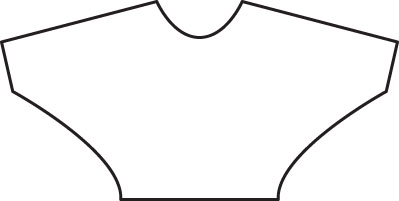 |
| A dolman
sleeved garment schematic. With clever
shaping or short rows, the sleeves can
be angled. |

Now that you're acquainted
with the various species of sleeves, how do
you pick the right one? Consider the pros
and cons of each type of sleeve, keeping in
mind your objectives in fitting the recipient
and (if you're designing your own garment)
design planning.
For example, if you're knitting
for someone else and you don't know the recipient's
actual size, the safest styles are the types
that can be knit from the top down to allow
for easy length adjustments, and that don't
require a specific cross-shoulder measurement:
the drop shoulder and raglan sleeve are best.
If you want a sleek, long-sleeved
top that can slide underneath other jackets
or sweaters, you need to minimize bulk under
the arms. Pick the set-in sleeve or a close-fitting
raglan or yoked design. These styles are also
best if you want to knit a body-conscious design,
with a nipped-in waist; waist shaping is lost
on loose-fitting garments.
In general, when you're concerned
with a good fit that complements the wearer
(as opposed to a "safe" fit that will accommodate
a small range of body sizes), set-in sleeve
styling is almost uniformly an ideal solution
to the problem of adding sleeves to a garment.
It works just as well for close-fitting tops
as for loose-fitting pullovers; it has style
lines that are friendly to most body types;
it requires minimal alteration to a pre-existing
sleeveless design; and a well-sized set-in sleeve
is always comfortable, with minimal fabric bulk
under the arm.
However, if your intention
is to incorporate a particular design feature,
such as colour or texture or a different construction
method, other styles may be more suitable. If
you want to preserve the lines of a vertical
or panel design, then a drop shoulder is your
best bet. If you want to knit a garment sideways
(cuff-to-cuff), the drop shoulder or dolman
style is the easiest way to go. And if you want
to knit everything in the round, with a minimum
of picking up, grafting or sewing, the yoked
and raglan styles would be your first choices,
requiring just a bit of grafting or picking
up at the underarm. Next best are the drop and
modified drop shoulder, with sleeves that can
be picked up from the armhole and knit down
to the wrist.
Adding a drop shoulder
or modified drop shoulder to a garment
To ease into sleeve design,
let's consider the most basic body and sleeve
shape. If you've got a loose-fitting vest
pattern, it's easy to design drop or modified
drop shoulder sleeves to fit.
If you feel a surge of panic
when you see the length of the discussion
below, don't worry! The actual steps are quite
simple. If they were reduced to algebraic
expressions, this discussion would in fact
be quite terse. However, as we are seeking
to postpone the introduction of algebraic
expressions until absolutely required, these
instructions are necessarily quite verbose.
If you can't bear to read on, skip
ahead to the précis.
Begin with taking
measurements
Usually, a vest has an
indented armscye; if the vest were shaped
like a plain rectangle, a flange of fabric
would extend over the shoulders. (Such vests
have been known to exist, so we won't ignore
them.)
 |
| Typical
vest shapes: from left to right, with
a curved armscye; with an angled armscye;
with a box-shaped armscye; and a plain
rectangular body. Note that in a plain
rectangular body (which would result
in a true drop shoulder style), the
upper body width is the same as the
lower body width |
From the vest design,
you should be able to work out some basic
dimensions that will affect your sleeve
design:

